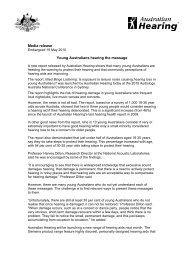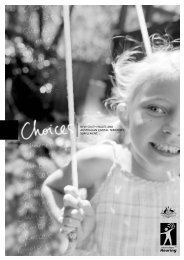to download PDF - Australian Hearing
to download PDF - Australian Hearing
to download PDF - Australian Hearing
You also want an ePaper? Increase the reach of your titles
YUMPU automatically turns print PDFs into web optimized ePapers that Google loves.
Tips&snippets<br />
Apeekatthepast<br />
“Such graceful form,<br />
not detracting from efficiency,<br />
these artful forms hid<br />
one’s deficiency.”<br />
At the turn of the 19th century, a new<br />
trend emerged in the design of<br />
mechanical hearing devices. Clumsy and<br />
bulky devices such as ear trumpets and<br />
long speaking tubes evolved in<strong>to</strong> devices<br />
that could be incorporated in<strong>to</strong> everyday<br />
items or worn on the person.<br />
This move <strong>to</strong>ward concealment may have<br />
encouraged more users <strong>to</strong> wear hearing<br />
devices since they were cosmetically or<br />
socially acceptable for public use. It was<br />
literally a work of art <strong>to</strong> combine the<br />
elements of disguise and functionality in<br />
a form that was aesthetically appealing<br />
and yet useful for those with mild <strong>to</strong><br />
moderate hearing loss.<br />
For a fascinating glimpse in<strong>to</strong> “discreet”<br />
hearing solutions from the past, visit<br />
http://becker.wustl.edu/ARB/<br />
Exhibits/cid/ for a virtual museum<br />
called Deafness in Disguise: Concealed<br />
<strong>Hearing</strong> Devices of the 19th and 20th<br />
Centuries. These four online exhibits<br />
have been prepared by the Central<br />
Institute for the Deaf and the Bernard<br />
Becker Medical Library of Washing<strong>to</strong>n<br />
University Medical Centre. Pictured are<br />
a few gems from this site.<br />
Courtesy of Central Institute for the Deaf, St. Louis<br />
Courtesy of Central<br />
Institute for the Deaf,<br />
St. Louis<br />
Courtesy of Central Institute for the Deaf, St. Louis<br />
Floral Aurolese Phone<br />
This phone was made by<br />
F.C. Rein around 1802.<br />
Despite its fragile<br />
appearance, it provided<br />
an acoustic benefit up <strong>to</strong><br />
10 dB over a limited<br />
frequency range and was<br />
appropriate for a person<br />
with a mild hearing loss.<br />
Aurolese Phones<br />
This F.C. Rein catalogue<br />
illustration shows a<br />
variety of Aurolese<br />
Phones and the various<br />
ways in which they could<br />
be disguised or made<br />
“invisible.”<br />
Amplivox “Purse”<br />
One ingenious example<br />
of a carbon hearing aid<br />
designed for camouflage<br />
was the purse model<br />
created by Amplivox<br />
around 1935. A battery<br />
pack and microphone<br />
were contained within the<br />
purse. The earpiece was<br />
held <strong>to</strong> the user’s ear<br />
while the purse containing<br />
the microphone faced<br />
the talker.<br />
Hear&Now 23

















